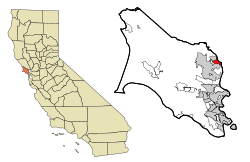Black Point-Green Point | |
|---|---|
 Location in Marin County and the state of California | |
| Coordinates: 38°6′35″N122°30′13″W / 38.10972°N 122.50361°W | |
| Country | |
| State | |
| County | Marin |
| Government | |
| • County Board | District 5 Eric Lucan |
| • Assembly | Damon Connolly (D) [1] |
| • State Senate | Mike McGuire (D) [1] |
| • U. S. Congress | Jared Huffman (D) [2] |
| Area | |
• Total | 2.90 sq mi (7.50 km2) |
| • Land | 2.83 sq mi (7.32 km2) |
| • Water | 0.069 sq mi (0.18 km2) 0.44% |
| Elevation | 13 ft (4.0 m) |
| Highest elevation | 190 ft (57.9 m) |
| Lowest elevation | 0 ft (0 m) |
| Population | |
• Total | 1,431 |
| • Density | 506.19/sq mi (195.44/km2) |
| Time zone | UTC-8 (PST) |
| • Summer (DST) | UTC-7 (PDT) |
| ZIP code | 94945 (Novato) |
| Area codes | 415/628 |
| FIPS code | 06-06982 |
| GNIS feature IDs | 2407857 |
Black Point-Green Point is a census-designated place (CDP) in Marin County, California, United States. It is unincorporated, sitting between the city of Novato to the southwest and the Petaluma River and San Pablo Bay to the northeast. The population was 1,431 at the 2020 census. [4]


